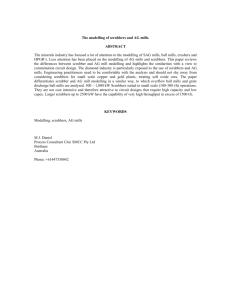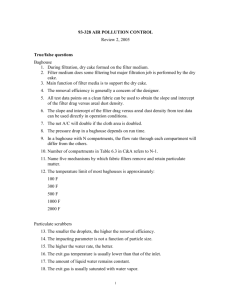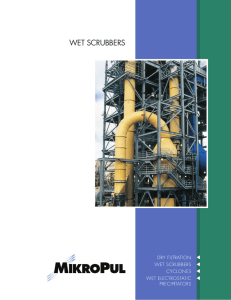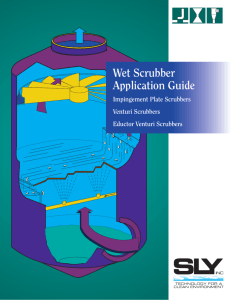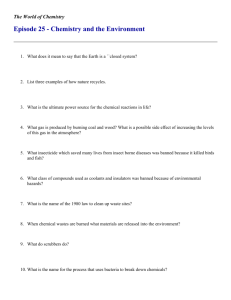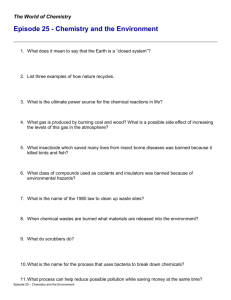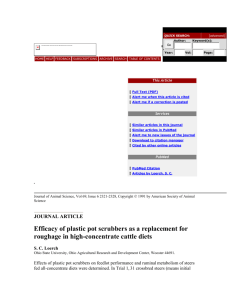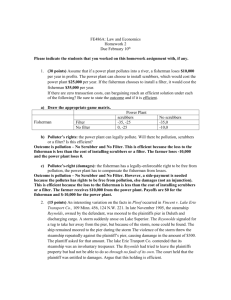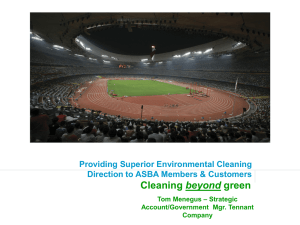Scrubbers
advertisement
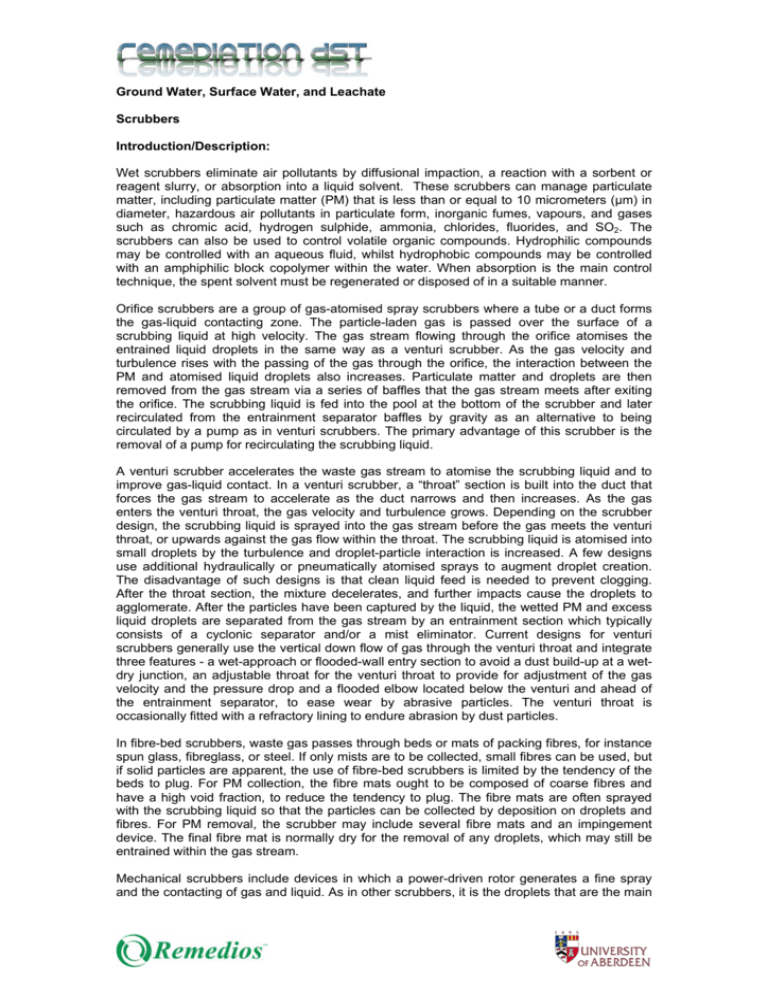
Ground Water, Surface Water, and Leachate Scrubbers Introduction/Description: Wet scrubbers eliminate air pollutants by diffusional impaction, a reaction with a sorbent or reagent slurry, or absorption into a liquid solvent. These scrubbers can manage particulate matter, including particulate matter (PM) that is less than or equal to 10 micrometers (µm) in diameter, hazardous air pollutants in particulate form, inorganic fumes, vapours, and gases such as chromic acid, hydrogen sulphide, ammonia, chlorides, fluorides, and SO2. The scrubbers can also be used to control volatile organic compounds. Hydrophilic compounds may be controlled with an aqueous fluid, whilst hydrophobic compounds may be controlled with an amphiphilic block copolymer within the water. When absorption is the main control technique, the spent solvent must be regenerated or disposed of in a suitable manner. Orifice scrubbers are a group of gas-atomised spray scrubbers where a tube or a duct forms the gas-liquid contacting zone. The particle-laden gas is passed over the surface of a scrubbing liquid at high velocity. The gas stream flowing through the orifice atomises the entrained liquid droplets in the same way as a venturi scrubber. As the gas velocity and turbulence rises with the passing of the gas through the orifice, the interaction between the PM and atomised liquid droplets also increases. Particulate matter and droplets are then removed from the gas stream via a series of baffles that the gas stream meets after exiting the orifice. The scrubbing liquid is fed into the pool at the bottom of the scrubber and later recirculated from the entrainment separator baffles by gravity as an alternative to being circulated by a pump as in venturi scrubbers. The primary advantage of this scrubber is the removal of a pump for recirculating the scrubbing liquid. A venturi scrubber accelerates the waste gas stream to atomise the scrubbing liquid and to improve gas-liquid contact. In a venturi scrubber, a “throat” section is built into the duct that forces the gas stream to accelerate as the duct narrows and then increases. As the gas enters the venturi throat, the gas velocity and turbulence grows. Depending on the scrubber design, the scrubbing liquid is sprayed into the gas stream before the gas meets the venturi throat, or upwards against the gas flow within the throat. The scrubbing liquid is atomised into small droplets by the turbulence and droplet-particle interaction is increased. A few designs use additional hydraulically or pneumatically atomised sprays to augment droplet creation. The disadvantage of such designs is that clean liquid feed is needed to prevent clogging. After the throat section, the mixture decelerates, and further impacts cause the droplets to agglomerate. After the particles have been captured by the liquid, the wetted PM and excess liquid droplets are separated from the gas stream by an entrainment section which typically consists of a cyclonic separator and/or a mist eliminator. Current designs for venturi scrubbers generally use the vertical down flow of gas through the venturi throat and integrate three features - a wet-approach or flooded-wall entry section to avoid a dust build-up at a wetdry junction, an adjustable throat for the venturi throat to provide for adjustment of the gas velocity and the pressure drop and a flooded elbow located below the venturi and ahead of the entrainment separator, to ease wear by abrasive particles. The venturi throat is occasionally fitted with a refractory lining to endure abrasion by dust particles. In fibre-bed scrubbers, waste gas passes through beds or mats of packing fibres, for instance spun glass, fibreglass, or steel. If only mists are to be collected, small fibres can be used, but if solid particles are apparent, the use of fibre-bed scrubbers is limited by the tendency of the beds to plug. For PM collection, the fibre mats ought to be composed of coarse fibres and have a high void fraction, to reduce the tendency to plug. The fibre mats are often sprayed with the scrubbing liquid so that the particles can be collected by deposition on droplets and fibres. For PM removal, the scrubber may include several fibre mats and an impingement device. The final fibre mat is normally dry for the removal of any droplets, which may still be entrained within the gas stream. Mechanical scrubbers include devices in which a power-driven rotor generates a fine spray and the contacting of gas and liquid. As in other scrubbers, it is the droplets that are the main collecting bodies for the dust particles. The rotor acts as a turbulence producer. An entrainment separator prevents any carry-over of spray. The simplest commercial devices of this type are fans upon which water is sprayed. Mechanically aided scrubbers are preceded by a cyclone or other pre-cleaner for removing coarse dust and/or larger debris. This kind of scrubber relies mostly on inertial interception for PM collection, and is competent of high collection efficiencies. An impingement-plate scrubber is a vertical chamber with plates set up horizontally inside a hollow shell. Impingement-plate scrubbers function as a counter current PM collection device. The scrubbing liquid flows down the tower whilst the gas stream flows upward. Contact between the liquid and the particle-laden gas takes place on the plates. The plates are equipped with openings that permit the gas to pass through. Some plates are pierced or slotted, whereas more complex plates have valve-like openings. The most straightforward impingement-plate scrubber is the sieve plate, which has round perforations. In this scrubber, the scrubbing liquid flows over the plates and the gas flows up through the holes. The gas velocity stops the liquid from flowing down through the perforations. Gas-liquid- particle contact is accomplished within the froth generated by the gas passing through the liquid layer. Complex plates, for instance bubble cap or baffle plates bring in an additional means of collecting the PM. The bubble caps and baffles are positioned above the plate perforations, which force the gas to turn before escaping the layer of liquid. Whilst the gas turns to avoid the obstacles, most PM is collected by impaction on the caps or baffles. Bubble caps and baffle plates can also prevent liquid from flowing down the perforations, if the gas flow is reduced. In all impingement-plate scrubbers, the scrubbing liquid flows across each plate and down the inside of the tower onto the plate below. After the bottom plate, the liquid and collected PM flows out of the bottom of the tower. Impingement-plate scrubbers are designed to provide the operator with access to each tray, making it easy to wash and maintain. As a result, impingement-plate scrubbers are more suitable for PM collection than packed-bed scrubbers. Particles greater than 1 µm in diameter can be collected efficiently by impingement-plate scrubbers, but particles <1 µm in diameter will infiltrate the devices. Spray scrubbers are empty cylindrical or rectangular chambers in which a gas stream is contacted with liquid droplets created by spray nozzles. A familiar type is a spray tower, where the gas flows upward through a bank or successive banks of spray nozzles. Comparable set-ups are occasionally used in spray chambers with horizontal gas flow. These have low gas pressure drops, and most of the contacting power is derived from the liquid stream. The necessary contacting power is gained through a combination of liquid pressure and flow rate. Physical absorption hinges on the properties of the gas stream and liquid solvent, namely the density and viscosity, in addition to specific characteristics of the contaminant(s) in the gas and the liquid stream such as diffusivity and equilibrium solubility. These properties are temperature dependent, and a lower temperature favours absorption of gases by the solvent. Absorption is also improved by a greater contacting surface, higher liquid-gas ratios, and higher concentrations in the gas stream. Chemical absorption might be limited by the rate of reaction, though the rate-limiting step is normally the physical absorption rate, not the chemical reaction rate. Condensation scrubbing is a fairly recent development in wet scrubber technology. Most standard scrubbers depend on the mechanisms of impaction and diffusion to accomplish contact between the PM and liquid droplets. In a condensation scrubber, the PM acts as condensation nuclei for the development of droplets. Normally, condensation scrubbing depends on establishing saturation conditions in the gas stream. Once saturation is attained, steam is injected into the gas stream. The steam produces a super saturated environment and leads to condensation of water on the fine PM in the gas stream. A device, such as a high efficiency mist eliminator, removes the large condensed droplets. Spray dry scrubbers are a broadly used flue-gas desulphurisation (FGD) technology. This process is restricted to a flue gas volume of around 200 MWe plants on average, consequently meaning the technology is employed in small to medium sized coal fired plants. A removal efficiency of over 90% SO2 has been accomplished using these scrubbers. A few advantages of using this technology are low waste disposal costs, low water consumption and a low-pressure drop. Contaminants suitable for treatment include PAHs, HCl, heavy metals and SO2. Applicability: The main contaminants viable for treatment via scrubbers are HCl, H2SO4, chlorine, SO2, and acidic/alkaline vapours. Acid gases are normally treated through the use of scrubbers. Limitations: • • • • Solubility limits of composition and temperature dependent exist for all minerals in water. Deposition can be avoided by increasing liquid blow down rate, using only caustic for neutralisation or replacing hard scrubber makeup water with deionised water will keep a low level of dissolved salts in the scrubber liquid. Operating with excessive dissolved solids. Sodium hypochlorite (NaOCl) is a product of neutralising Cl2 with NaOH. If the scrubber blow down liquid is acidified (as in a waste water treatment plant) the NaOCl breaks down, releasing Cl2 gas. Improper wastewater treatment. Most incinerator flue gas scrubbers are constructed of the least expensive acid proof materials such as polypropylene or similar, and are sensitive to high temperatures. Prior to scrubbing, the hot flue gas must be cooled. Waste combustion forms small particles for which additional equipment must be specified. Most flue gas scrubbers recirculate to reduce the rate of blow down to water treatment. Circulating pump cavitation can sharply reduce the rate of scrubbing liquid available and damage the pump. Performance Data: Scrubbers can lower concentrations of particular water-soluble acid, base and organic contaminants and they are commonly exploited for environmental protection. Due to the fact scrubbers are so efficient at capturing particulates, a filter is required to remove the particulate from the system. The filters can be disposable or renewable. Cost: The approximate cost is thought to range from £ 2000 - £ 130,000 per m3 /sec.
